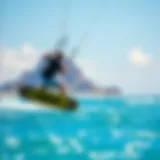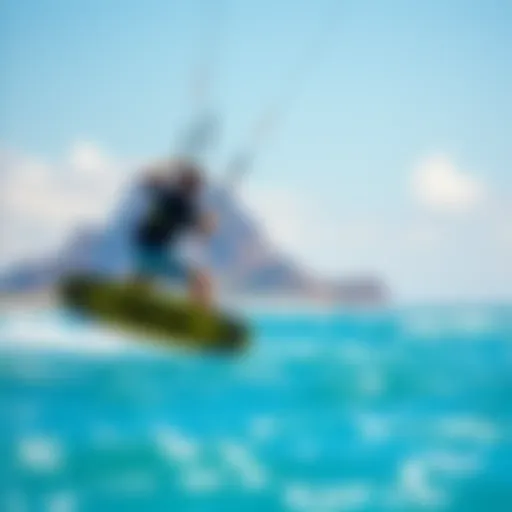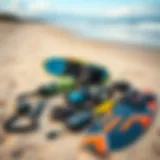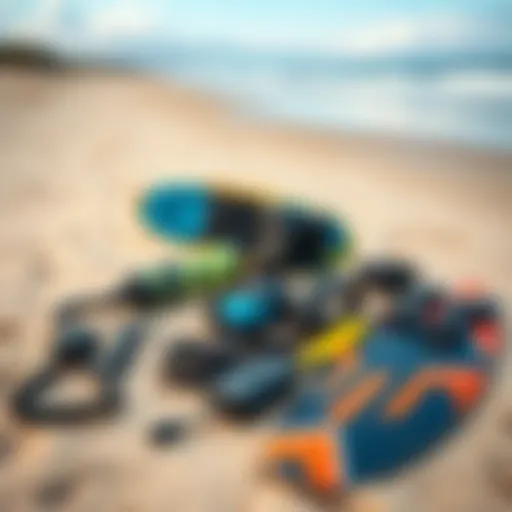National Wind Map: Essential Guide for Kiteboarders


Intro
When it comes to kiteboarding, wind is the name of the game. Every kiteboarder's adventure hinges on a solid understanding of wind patterns, making a national wind map an invaluable resource. This article sheds light on how these maps are crafted and their significance for both the novice and seasoned kiteboarder.
Imagine stepping onto the beach, a kite in hand, and knowing precisely where to catch that wind just right. A well-formulated wind map gives you that insight, helping to navigate the myriad factors that influence your ride—like local geography, seasonal wind changes, and the interplay of temperature and pressure. It’s not merely information; it’s the difference between an exhilarating session on the waves and a frustrating day battling the elements.
By bridging kiteboarding conditions with local spots, such maps redefine the sport. They equip enthusiasts to make informed decisions and ultimately optimize their kiteboarding experiences. In this journey, we aim to explore the role of technology in wind mapping, delve into essential gear, share some expert tips, and ensure you’re well-prepared for your next kiteboarding escapade. Buckle up—let’s catch some gusts!
Understanding National Wind Maps
Understanding national wind maps is crucial for kiteboarding enthusiasts who want to elevate their experience on the water. These maps serve as vital tools that capture the complex interactions of wind patterns across various regions, translating this data into easily digestible formats. For kiteboarders, having accurate wind information can make the difference between a thrilling session and a frustrating day stuck on land.
Definition and Purpose
A national wind map is a graphical representation that displays wind speed, direction, and patterns across a geographical area. Its primary purpose is to provide kiteboarders with a clear picture of how wind conditions fluctuate in different locales. This kind of data not only helps in choosing the right spot for kiteboarding but also informs the kiteboarders about potential risks associated with varying wind strengths.
The advantages of using national wind maps are manifold. First, they allow kiteboarders to plan their trips more effectively, optimizing their time on the water. Second, they help in understanding local conditions and how they can change quickly due to geographical features or weather fronts. Lastly, these maps can enhance safety during kiteboarding, as understanding wind patterns can help kiteboarders avoid hazardous situations that could arise from unexpected gusts or shifts in wind direction.
Components of a Wind Map
The key components of a wind map include:
- Wind Speed: Displayed often in miles per hour or kilometers per hour, indicating the strength of the wind at various locations.
- Wind Direction: Usually represented by arrows or lines on the map that point in the direction the wind is blowing.
- Geographical Features: Landforms such as mountains, valleys, and coastlines are relevant factors that can affect local wind patterns and are often included in these maps.
- Temporal Data: Some wind maps provide time-specific data, indicating how wind conditions may change over the course of a day or season.
A well-designed wind map integrates these components seamlessly, allowing users to glean information effortlessly. Moreover, the introduction of color gradients can depict strength, making it easier to visualize where the ideal wind conditions exist.
In summary, comprehending national wind maps is not merely an academic exercise for kiteboarders; it is essential for ensuring enjoyable and safe kiteboarding experiences. Understanding how to read and utilize these maps can empower enthusiasts to make informed decisions, thus enabling them to tackle the challenges of wind effectively.
"Kiteboarding is as much about understanding the elements as it is about skill; mastering the wind changes the game."
By grasping the definition, purpose, and components of national wind maps, kiteboarders can significantly enhance their approach to this exhilarating sport.
The Importance of Wind Data for Kiteboarding
Understanding wind data is crucial for kiteboarders, both to enhance performance and to ensure safety. Kiteboarding relies heavily on an athlete's ability to read and respond to wind conditions. Knowing the wind's nuances can mean the difference between a successful ride and a potentially hazardous situation. This section dives deep into the layers of importance that wind data holds for kiteboarding enthusiasts.
Impact on Kiteboarding Performance
When kiteboarders hit the water, they're not just thinking about their next trick or the waves; they must also consider the local wind patterns. Wind data conveys not only the speed but also the direction of the wind, which directly affects how a rider maneuvers on the water. For instance, in locations where strong winds are common, kiteboarders may utilize larger kites to capitalize on the conditions, while lighter winds may call for smaller kites. This wisdom in gear selection can enhance one’s performance significantly.
Further, understanding wind gusts can improve timing and tack efficiency. If a kiteboarder recognizes that gusts tend to funnel around certain shoreline features, they can make real-time adjustments to their strategy, which might allow them to glide smoother or perform aerial tricks more safely. This tactile relationship to wind data forms an essential part of wielding a kite effectively. Thus, a concerted effort in checking detailed wind data can improve results during competitive seasons or casual outings alike.
Benefits of Accurate Wind Data:
- Better gear selection for specific conditions
- Enhanced timing for jumps and maneuvers
- Improved overall enjoyment and less frustration
In short, performance is closely knit to the quality and accuracy of the wind data a boarder can access. A kiteboarder who neglects to observe wind patterns is akin to a sailor ignoring the tides. Without a doubt, integrating wind data into the riding routine propels enthusiasts to new heights, or at the very least, provides a more pleasurable experience on the water.
Safety Considerations
While the excitement of kiteboarding is undeniable, so too is the need for safety. Wind conditions can change in the blink of an eye, transforming a pleasant day on the water into a perilous situation. Understanding and applying wind data not only enhances performance but serves as a critical aspect of safety in the sport.
Monitoring real-time wind data allows kiteboarders to assess if they’re prepared for sudden shifts in conditions. For example, if a kiteboarder is out on a particularly calm day and suddenly encounters gusty winds, it becomes imperative to modify their riding style immediately or even return to shore if conditions are deemed unsafe.
“Knowing when to ride and when to retreat could save your life.”
The boundaries of safety extend to being aware of local conditions such as wind shadow areas or areas prone to sudden wind changes due to proximity to mountains or buildings. Such knowledge not only serves the rider but helps inform fellow enthusiasts—creating a safer environment in locations where kiteboarding reigns.
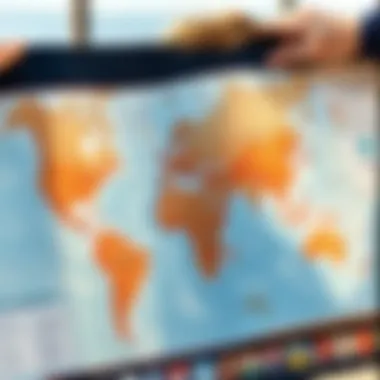

Key Safety Factors to Consider:
- Regularly check updated wind forecasts.
- Understand the geographical influences on wind currents.
- Wear safety gear and have an emergency plan in place.
Having a grip on these safety considerations ensures that kiteboarders can navigate their passion without needless risks. With every ride, knowledge of wind data stands as both a performance enhancer and a safety net, emphasizing its central role in the kiteboarding spectrum.
Technological Advances in Wind Mapping
In the rapidly evolving world of kiteboarding, staying ahead hinges not just on skill, but also on information, particularly about the wind. Advancements in technology have transformed wind mapping, enabling kiteboarders to harness detailed data and make informed decisions about their rides. With tools that offer real-time insights and predictive models, kiteboarders can gauge wind conditions like a pro, enhancing both performance and safety. This section examines key advancements in wind mapping technology and how they directly influence kiteboarding practices.
Data Collection Methods
Collecting wind data is no longer a guessing game. Modern methods have taken giant leaps from traditional techniques like anemometers and flags fluttering in the breeze. Now kiteboarders benefit from a mix of high-tech solutions:
- Satellite Imagery: Satellites orbiting above our atmosphere can provide a macroscopic view of wind patterns across vast regions. This kind of data allows kiteboarders to not only see current conditions but also understand historical patterns.
- Drones: These flying marvels can be sent out to capture localized wind speeds and directions, offering kiteboarders a bird’s-eye view of the ideal setting. Drones can venture into zones that may be too dangerous for humans and gather precise information.
- Crowdsourced Data: Platforms like Windy and KiteMap encourage users to contribute their own observations. This community approach adds invaluable details about local wind variations that formal systems might miss. The sharing culture among kiteboarders benefits everyone.
"Knowledge is power. In kiteboarding, understanding wind data can be the difference between soaring high or facing a tough fall."
Understanding these methods equips kiteboarders with the knowledge they need to select ideal locations — maximizing thrill while minimizing risk.
Real-time Monitoring Systems
Once the data is collected, the question arises: how do kiteboarders access this information in a usable format? Welcome to the world of real-time monitoring systems. These systems dynamically track wind conditions, presenting live updates that are essential for on-the-water decision making. Here’s how they enhance kiteboarding experiences:
- Mobile Apps: Apps such as Windy and Kiter’s Paradise deliver live updates on wind speed and direction based on up-to-the-minute data. With a tap, users can access local forecasts, making it easier to find that sweet spot where the wind is just right.
- On-site Stations: Many popular kiteboarding locations now feature advanced weather stations that give real-time data accessible via the internet. These stations measure wind velocity, temperature, and humidity, enriching user input.
- Alerts and Notifications: Many kiteboarding apps allow users to set wind alerts. This means that if conditions reach a certain threshold, kiteboarders receive a notification straight to their phone, ensuring they never miss an opportunity to ride.
The integration of these tools reflects a new age in kiteboarding where real-time information is king, guiding enthusiasts to make precise and timely decisions.
In summary, the advances in wind mapping technology, from sophisticated data collection methods to real-time monitoring, have revolutionized the kiteboarding landscape, placing detailed insights right in the hands of every surfer brave enough to ride the wind.
Interpreting Wind Map Data
Understanding wind map data is crucial for kiteboarding enthusiasts who seek to maximize their time on the water. Interpreting this data enables kiteboarders to make informed decisions regarding when and where to kiteboard, ensuring optimal conditions for their activities. It’s not just about enjoying the ride; it’s about understanding the elements at play.
Understanding Wind Patterns
Wind patterns reveal how air flows across different regions and how this flow interacts with the local geography. For kiteboarders, familiarizing oneself with these patterns can mean the difference between a thrilling day on the water and a frustrating experience.
Kiteboarding requires a keen awareness of both local and broader wind movements. For instance,
- Coastal areas often experience sea breezes, characterized by winds blowing inland during the day as cooler air replaces the rising warm air over the land.
- Conversely, at night, land breezes may occur, reversing the flow. The understanding of these phenomena allows kiteboarders to pick their spots wisely.
Another aspect worth knowing is how topography—such as mountains or urban structures—shapes wind patterns. A valley might create gusty conditions that aren’t present a few hundred yards away. A kiteboarder who can read these nuances can better position themselves for a successful session.
In addition to geographical effects, regional climatic conditions—like prevailing winds—should be part of a kiteboarder's toolkit when assessing wind maps. These maps often depict wind speeds and direction, but understanding regional climate helps one predict variations day-to-day.
Analyzing Wind Speeds
Wind speed is another integral component on a wind map that kiteboarders cannot afford to overlook. However, interpreting this data involves more than just glancing at numbers; it requires an understanding of what different wind speeds mean for kiteboarding.
Generally, the following wind speeds can be categorized as:
- Light Winds (0-10 knots): These conditions might be okay for beginners, but experienced kiteboarders will likely find them insufficient for engaging maneuvers.
- Moderate Winds (10-20 knots): Ideal for most kiteboarders, it allows for a good mix of jumps and speed. At this range, flexibility in kite choice should be considered, making it essential to have equipment suited for varying conditions.
- Strong Winds (20+ knots): This range can push even seasoned kiteboarders, often requiring specialized gear to handle such intensity safely. Understanding the threshold of one's skill and equipment can safeguard against accidents.
The interpretation of wind speeds also extends into predicting changes. For example, an increase in wind speed can signal an approaching front, implying that conditions may shift from good to risky pretty rapidly. Keeping an eye on wind reports and maps allows kiteboarders to anticipate these alterations and prepare accordingly.
"Understanding wind patterns and speeds can transform your kiteboarding experience from merely satisfactory to exhilarating. Knowing what wind conditions work for your style can change the game completely."
In summary, keeping a close watch on wind map data, understanding the specific patterns and winds, and being aware of their impact on your gear and abilities can lead to enhanced kiteboarding experiences. The interplay of various factors from local geography to broader climatic trends constitutes a comprehensive viewpoint that kiteboarders should grasp. This depth of understanding not only elevates the riding experience but cultivates a deeper appreciation of the sport itself.
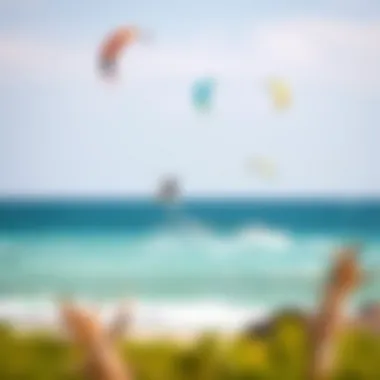

Regional Variations in Wind Conditions
Understanding regional variations in wind conditions is crucial for kiteboarders. These variations significantly impact where, when, and how you can kiteboard. Winds are not uniform; different areas have their unique wind profiles influenced by local geography, climate patterns, and seasonal changes. Knowing these regional differences can optimize your kiteboarding experience, ensuring you chase the winds that suit your skills and gear.
Top Kiteboarding Locations
Certain regions stand out in the kiteboarding community, drawing both novice and expert kiteboarders. Here are a few top locations renowned for their favorable wind conditions:
- Hatteras, North Carolina: Often hailed as the kiteboarding capital of the East Coast, Hatteras offers diverse wind patterns with consistent trade winds, especially in summer. Conditions are perfect for long, flat-water sessions or thrilling downwinders.
- Tarifa, Spain: Known as the wind capital of Europe, Tarifa is famous for its strong and reliable winds, thanks to the unique geography of the surrounding area. The variety of spots here accommodates all kinds of kiteboarders, from beginners to pros.
- Cumbuco, Brazil: With steady trade winds blowing almost year-round, Cumbuco is a paradise for kiters. What sets it apart is its blend of flat-water lagoons and exciting wave spots, providing versatile conditions.
- Cape Town, South Africa: The stunning backdrop of Table Mountain pairs with the infamous Cape Doctor wind, creating thrilling conditions for experienced kiteboarders. Numerous spots cater to different skill levels and preferences.
These locations not only have favorable wind conditions but also vibrant kiteboarding communities. Engaging with locals can provide invaluable insight into understanding the wind patterns better, so don’t hesitate to communicate!
Local Wind Influences
Local wind influences can drastically change kiteboarding conditions. Factors like terrain, bodies of water, and metropolitan areas can alter wind behavior. Here are a few aspects to consider:
- Geographic Features: Mountains, hills, valleys, and even buildings can channel or block winds, affecting where the strongest winds are found. For instance, climbing to a higher elevation might give you a better sense of wind direction and strength.
- Thermal Winds: In coastal areas, the difference in temperature between the ocean and land can create thermal winds. As the land heats up, it generates rising warm air, drawing cooler air from the water and producing reliable onshore winds during hot days.
- Sea Breezes: Locations along the coastline often experience sea breezes, particularly during summer. These can create perfect conditions for kiteboarding in the afternoons, as cooler air replaces the rising warm air over land. Understanding when these breezes are likely to kick in can be a game-changer.
- Local Weather Patterns: Always keep tabs on local forecasts. Rain, storms, or other weather occurrences can shift wind patterns temporarily. Engaging with local kite schools or clubs can help you stay informed about daily or seasonal wind variations.
"The difference between a good kiteboarding session and an exceptional one often hinges on understanding the local wind conditions."
By understanding regional variations and local influences, kiteboarders can better choose their locations and times, maximizing their time on the water.
Case Studies of Wind Maps in Action
Understanding how wind maps translate into real-world kiteboarding experiences is crucial for both beginners and veterans alike. By examining specific case studies, kiteboarders can glean insights that enhance their understanding of local wind conditions and improve their performance on the water. These accounts showcase the practical benefits of wind mapping, serving as a bridge between theory and application.
Successful Kiteboarding Events
Over the years, an array of kiteboarding events have thrived thanks to effective wind mapping. For instance, during the 2019 U.S. Kiteboarding Nationals held in Cape Hatteras, North Carolina, the event organizers utilized a regional wind map that illustrated prevailing wind patterns for several weeks leading up to the competition. This proactive approach not only informed athletes about the best times to practice but also helped ensure safety for all participants.
The data from the wind map indicated a consistent Southern breeze, which turned out to be perfect for the planned race locations. Participants could strategically fine-tune their gear choices, picking specific kites that matched the expected wind strength. Consequently, this meticulous preparation led to heightened performance and a thrilling competition.
Additionally, the Kite Surf World Cup in Europe also showcased the vital role of wind maps. By integrating real-time wind data into their planning, the organizers managed to adjust heats based on unexpected changes in wind conditions. This adaptability ensured that all competitors faced fair scenarios. Witnessing these successful events illustrates that kiteboarding outcomes are often directly influenced by astute awareness of wind dynamics.
Individual Experiences
Beyond organized events, individual kiteboarders can also share compelling stories that highlight the importance of wind mapping. Take Clara, an enthusiastic amateur kiteboarder, who recounted her thrilling day at Maui's Hookipa Beach.
Before heading out, Clara checked her local wind map, which indicated a steady North-Northwest wind, ideal for the surf conditions that day. Armed with her chosen two-line kite, she went out and had one of her best sessions yet. As she rode the waves, she felt a rush, confident that the wind would support her maneuvers.
Conversely, she recalled a day when a misinterpretation of wind maps led to a less-than-ideal experience. Wanting to catch some strong winds, she focused only on a static map, neglecting the insights available from real-time updates. The afternoon turned out to be flat, and the condition dampened her spirits, leading to the understanding that current data is critical for maximizing kiteboarding experience.
Stories like Clara's resonate with many kiteboarders, reminding them that understanding wind maps can mean the difference between a flat session and an exhilarating ride.
"Being aware of wind conditions isn't just about safety; it transforms your entire kiteboarding journey. Always remember to factor in local wisdom along with the maps."
By sharing personal accounts and event successes, kiteboarders can foster a sense of community while underscoring the importance of wind maps. Recognizing these case studies not only educates but also inspires practitioners to seek out the most beneficial wind conditions for an unforgettable kiteboarding experience.
Future Trends in Wind Mapping Technology
The landscape of wind mapping is evolving rapidly, influenced by new technologies and methods that are significantly improving how kiteboarders understand and utilize wind conditions. These advancements not only bolster performances but also enhance safety measures on the water. As kiteboarding enthusiasts seek to refine their skills and experiences, recognizing the future trends in wind mapping becomes paramount. In this section, we will examine emerging technologies that are changing the game in wind data acquisition and interpretation, as well as how these developments impact kiteboarding practices themselves.
Emerging Technologies
As the world embraces smarter technologies, wind mapping emerges as a domain ripe for innovation. A few notable developments that are making waves include:
- Drones and UAVs: Unmanned aerial vehicles can collect wind data at different altitudes and locations that were previously hard to access. This aerial perspective helps in capturing real-time wind patterns that are essential for kiteboarders looking for the best spots to launch.
- Machine Learning Algorithms: Advanced analytics are being employed to process vast amounts of wind data more effectively. By using patterns derived from historical data, machine learning can predict wind conditions with remarkable accuracy, providing kiteboarding enthusiasts with forecasts they can trust.
- Mobile Apps: Various applications are hitting the stores, such as Windy or KiteMap, which combine data sources from weather stations, satellite imagery, and user feedback. These allow kiteboarders to receive up-to-the-minute data while out on the water or while planning their next adventure.
Some readers might find the blend of technology and sports daunting. However, understanding these tools can make all the difference in tailoring kiteboarding experiences to one’s preferences and skill levels.

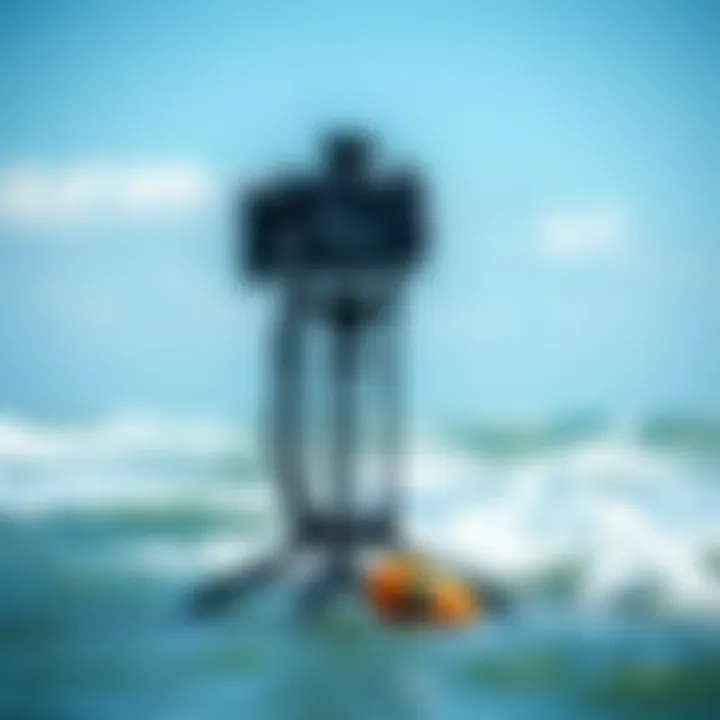
Impact on Kiteboarding Practices
The emergence of these technologies is reshaping kiteboarding in several vital ways:
- Enhanced Decision-Making: With better data at their disposal, kiteboarders can decide when and where to go out with much greater confidence. Knowing the precise wind patterns can mean the difference between an exhilarating ride and a frustrating afternoon.
- Safety Improvements: Kiteboarding inherently carries risks, especially when wind conditions shift unexpectedly. Advanced mapping tools help in forecasting sudden changes, enabling riders to make better decisions about safety thresholds that they might not have noticed before.
- Accessibility of Windsurfing Locations: As these tech innovations spread, they also democratize information. Traditional kiteboarding spots can become crowded; thus, knowing the wind conditions of lesser-known locations via new mapping technologies can open up options for kiteboarders.
"The advancements in technology make it easier for us to chase the wind, transforming each session from mere chance into a calculated craft."
Integrating Wind Maps with Kiteboarding Gear
The relationship between wind maps and kiteboarding gear is more intricate than it might appear at first glance. As kiteboarding enthusiasts, understanding how to integrate wind map data with the right equipment is key to enhancing performance on the water. This section explores these connections in detail.
Choosing the Right Equipment
When navigating through the exhilarating world of kiteboarding, having the right equipment can mean the difference between a sensational day on the waves and a frustrating experience. It's not just about picking a kite and a board; it's about understanding the wind conditions laid out on wind maps.
A kite’s size significantly influences how it behaves in various wind speeds. For example, larger kites generate more power, making them ideal for lighter winds. Conversely, smaller kites excel in stronger gusts. Wind maps show not just average wind speeds, but also variances and gust responses across different locations. Kiteboarders must analyze these maps to make informed decisions:
- Light Wind (10-15 mph): Opt for larger kites (12m to 16m).
- Moderate Wind (15-25 mph): Medium-sized kites (8m to 12m) are suitable for most conditions.
- Strong Wind (25 mph and above): Smaller kites (5m to 7m) ensure safety and control.
Using Technology in Gear Selection
Technology plays an essential role in how kiteboarders select their gear. With wind mapping apps and platforms emerging, kiteboarders can access real-time data that directly informs their choice of equipment. Knowing how to leverage this technology is vital.
A popular tool among kiteboarders is specialized mobile applications that provide updates on wind conditions, as well as alerts on sudden changes. Using these platforms to pair forecasts with your gear gives you a strategic edge.
Consider the following when using technology for gear selection:
- Mobile Apps: Applications like Windy or kiterwise provide live updates on wind conditions, helping users choose gear tailored for the day’s specifics.
- Sensors and Trackers: Devices can be affixed to kites to collect data on performance, so you can review how different gear reacts under varying conditions from past experiences.
- Community Feedback: Many kiteboarding forums on platforms like Reddit or Facebook can offer insights into what gear works best in specific conditions, depending on local wind characteristics.
"Choosing the right equipment based on wind maps and technological insights sets the stage for successful kiteboarding adventures."
User-generated Content and Wind Mapping
In the ever-expanding world of kiteboarding, user-generated content plays a crucial role in enhancing the value and accuracy of wind mapping. This isn’t just about individuals sharing their own experiences; it’s about creating a comprehensive database of knowledge and insights that can significantly inform kiteboarders of all skill levels. Collectively, the kiteboarding community can share real-time wind conditions, local insights, and specific sites that might not be highlighted in more traditional maps.
Community Contributions
Community contributions are vital to building robust wind mapping resources. Kiteboarders, whether they are seasoned pros or newbies, often have unique anecdotes and observations to share. For instance, a weekend warrior may detail how on-shore breezes at a particular beach can shift dramatically with tide changes, insights that might not be captured in formal wind maps.
- Encouraging Participation: Platforms like Facebook groups, specialized kiteboarding forums, and community-driven sites such as Reddit can act as melting pots for information sharing. Here, users can upload their local conditions, rate different kiteboarding spots, and provide visual content to bolster their claims.
- Data Calibration: When multiple contributions converge around a single location, you can start to identify patterns and anomalies. This flow of data helps validate existing maps or signal when a map's representation is outdated or misleading.
"What one kiteboarder sees as a sweet spot, another might view as a turbulent mess. That’s the beauty of community data—tempered by varied experiences."
Collaborative Wind Mapping Efforts
The idea of collaborative wind mapping efforts takes community contributions a step further. By working together, kiteboarders can create a more dynamic and informative wind map that captures real-time data from various locations, thus making it a living document that evolves with community input.
- Crowdsourced Data: There are several initiatives where kiteboarders can contribute to shared mapping projects. Apps like Windy or KiteMap encourage users to input wind speeds and directions, creating a pool of data that anyone can access.
- Integration with Tech Tools: Collaboration doesn’t stop at inputting information. Kiteboarding enthusiasts can use GPS devices or smartphone apps that automatically upload wind readings straight to these community maps. This kind of tech-assisted participation not only boosts accuracy but also reliability.
- Building a Knowledge Base: Combined efforts lead to a better understanding of the microclimates affecting kiteboarding locations. Each contribution enriches the pool of knowledge, enabling everyone to make more informed decisions.
In summary, user-generated content and collaborative efforts create a vibrant community fabric that significantly enhances wind mapping for kiteboarders. Through collaboration, integrity, and the spirit of sharing, kiteboarders can elevate their experiences and cultivate a deeper connection to the wind that guides them.
Finale
As we tie up the insights shared throughout this article, it's crucial to underscore the significance of understanding national wind maps for kiteboarding enthusiasts. The relationship between wind patterns and kiteboarding performance is not just theoretical; it directly affects every kiteboarder's experience on the water. Having access to reliable wind data means that kiteboarders can plan their outings more effectively, ensuring that they hit the water at the right time and place for optimal conditions.
Summarizing Key Insights
In summary, national wind maps serve as invaluable resources, capturing vital data encompassing wind speeds and conditions across various regions. Highlights of this exploration include:
- Understanding Wind Mapping: The definition and components of wind maps were discussed, emphasizing their role in informing kiteboarding practices.
- Performance and Safety: Kiteboarding performance hinges on wind conditions. Additionally, understanding the safety implications of wind data can prevent accidents, allowing for a more enjoyable experience on the water.
- Emerging Technologies: The future of wind mapping is bright with advancements in technology. These innovations can provide kiteboarders with more precise data and real-time information, thus enhancing their performance and safety.
- Community Engagement: User-generated content contributes towards a richer data set, fostering a sense of community among kiteboarders, and promoting collaboration in improving wind mapping efforts.
Final Thoughts on Wind Mapping
Wind mapping is more than just collecting data; it’s about empowering kiteboarders to make informed decisions. As kiteboarding continues to grow as a sport, the integration of advanced wind mapping technologies will undoubtedly influence how enthusiasts engage with their surroundings. Understanding when and where the wind is favorable not only heightens performance but also opens the door to new adventures. It’s about catching the right gust and riding the wave of data that leads to an exhilarating kiteboarding experience.
